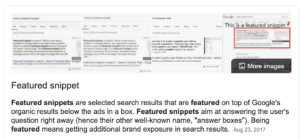When it comes to running a website, one of the most important things all business owners and website developers need to take into account is how to boost a website’s position on a search engine’s result page. By placing higher on a search engine results page, your website will have a higher chance of receiving more traffic, more conversions, and more credibility.
One way to boost your website’s placement on the search engine’s result page is through the use of schema markups. A schema markup is a piece of microdata you can add to the HTML of your website’s pages. This microdata informs search engines what the specific webpage is about by including tags related to the webpage’s content. Though a webpage’s content may seem clear to human eyes, to a search engine, a webpage can be ambiguous if not marked properly.
Like any other SEO measure, a schema markup can’t directly affect your website’s search engine result ranking. Your website’s ranking won’t rise to the top of the search engine result page overnight – like most SEO tactics, it will take time to see any potential changes. By employing schema markup along with other SEO tactics, you simply get a higher chance of bumping your website up the search engine results page.
In this article, we’ll be going over two specific types of microdata that can help your website’s ranking: rich snippets and featured snippets.\

What are rich snippets and featured snippets?
Snippets are pieces of structured data that reflect in a website’s listing on a search engine results page. There are two types of snippets: rich and featured.
A rich snippet basically helps in adding extra information to your website’s listing that will be useful or relevant for a search engine query. For example, an ordinary website listing may only have the website’s name, URL, and a brief preview of the webpage’s text in gray. However, a website with structured page data reflecting a rich snippet will have extra information in the portion with gray text. Instead of a preview of the webpage’s contents, the section will include more specific details. These details can include reviews, prices, whether an item is in stock or not, or even a location.
Featured snippets, on the other hand, involve previewing a section of a website’s page that is relevant to the search engine query. These previews are usually at the top of a search engine results page, and while they don’t show the entire webpage, they show and bold the section that best answers your search. If you are searching for a date or something that doesn’t take too much explanation, sometimes the featured snippet will even showcase that information at its top. Featured snippets may also come in the form of images or even videos depending on your search.
One difference between these two types of snippets, outside of the type of information they present to a search engine user, is how their data is structured. For rich snippets, you need to input specific tags into your website’s coding for them to appear. Featured snippets, on the other hand, don’t necessarily need extra structured data to appear. Instead, you can implement extra tags to boost your website’s chances of being highlighted as a featured snippet. However, for a featured snippet to appear, your website needs to organically be in the top five websites listed on a search engine result page. Depending on your site’s relevance to the search query, the search engine may choose your website to be used as a featured snippet.
Overall, rich snippets and featured snippets play an important role in streamlining a search engine user’s experience. The end goal for all search engines is to provide a user-friendly and user-oriented experience, so be sure to keep that in mind when deciding on your website’s design and its content.
Types of Schemas
Now that you’re familiar with the types of snippets, it’s time to go into more detail on the types of schemas you can incorporate within your snippets. We list a few useful examples here.

- Review Schema
This type of schema is specifically for rich snippets. Appearing in the gray text portion of a website listing, a review schema will inform search engine users of how highly rated a product is. You can depict the review in several ways, whether it’s giving an aggregate rating or listing a particular item’s rating out of five stars.
- FAQ Schema
The FAQ schema features a list of questions and their answers listed on the FAQ page of your website. This type of schema takes the form of a drop-down list beneath your website’s listing on a search engine results page. By clicking on a question, search engine users can see its answer. As opposed to other schemas, this type of schema doesn’t necessarily appear at the very top of the search engine results page.
- How-To Schema
The how-to schema provides a brief preview of a list of actions in a how-to. Typically numbered off, the details in a how-to schema appear in a box at the top of the search engine results page. If your website focuses on recipes or provides DIY projects, this type of schema is useful in showing the type of ideas or steps your website offers.
- Q&A Schema
The Q&A schema appears below a Q&A website, such as Quora or Yahoo Answers, and shows a range of answers given for a specific question. The answers are typically sorted into card-like spaces, and the schema will even mark which answer is the top one. This type of schema doesn’t necessarily show up at the top of a search engine result’s page, but it does get the job done in answering a search engine user’s query.
There are many SEO strategies to employ when it comes to raising your website’s search engine result ranking, however, at the end of the day, the most important thing is to focus on providing a user-oriented experience.















